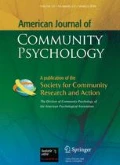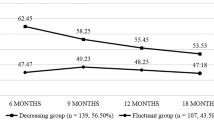Abstract
Urban residents experience a wide range of traumatic events and are at increased risk of assaultive violence. Although previous research has examined trajectories of posttraumatic stress (PTS) through latent class growth analysis (LCGA) among persons exposed to the same index events (e.g., a natural disaster), PTS trajectories have not been documented among urban residents. The aims of this study were to conduct LGCA with a sample of trauma survivors from Detroit, Michigan (N = 981), and to explore predictors of trajectory membership. Participants completed three annual telephone surveys, each of which included the posttraumatic stress disorder (PTSD) Checklist-Civilian Version. Four PTS trajectories were detected. Although the majority evidenced a trajectory of consistently few symptoms (Low: 72.5 %), 4.6 % were in a trajectory of chronic severe PTSD (High), and the remainder were in trajectories of consistently elevated, but generally subclinical, levels of PTS (Decreasing: 12.3 %; Increasing: 10.6 %). Socioeconomic disadvantage (e.g., lower income), more extensive trauma history (e.g., childhood abuse), and fewer social resources (e.g., lower social support) were associated with membership in higher PTS trajectories, relative to the Low trajectory. The results suggest that efforts to reduce PTS in urban areas need to attend to socioeconomic vulnerabilities in addition to trauma history and risk for ongoing trauma exposure.

Similar content being viewed by others
References
American Psychological Association. (1994). Diagnostic and statistical manual of mental disorders (4th ed.). Washington, DC: Author.
Andruff, H., Carraro, N., Thompson, A., Gandreau, P., & Louvet, B. (2009). Latent class growth modeling: A tutorial. Tutorials in Quantitative Methods for Psychology, 5, 11–24. Retrieved from http://www.tqmp.org.
Asparouhov, T., & Múthen, B. (2013). Auxiliary variables in mixture modeling: 3-step approaches using Mplus. Retrieved from www.statmodel.com.
Austin, S. B., Jun, H., Jackson, B., Spiegelman, D., Rich-Edwards, J., Corliss, H. L., et al. (2008). Disparities in child abuse victimization in lesbian, bisexual, and heterosexual women in the Nurses Health Study II. Journal of Women’s Health, 17, 597–606. doi:10.1089/jwh.2007.0450.
Bernstein, D. P., Fink, L., Handelsman, L., Foote, J., Lovejoy, M., Wenzel, K., et al. (1994). Initial reliability and validity of a new retrospective measure of child abuse and neglect. American Journal of Psychiatry, 15, 1132–1136. Retrieved from http://ajp.psychiatryonline.org/.
Bernstein, D. P., Stein, J. A., Newcomb, M. D., Walker, E., Pooge, E., Ahluvalia, T., et al. (2003). Development and validation of a brief screening version of the Childhood Trauma Questionnaire. Child Abuse and Neglect, 27, 169–190. doi:10.1016/S0145-2134(02)00541-0.
Berntsen, D., Johannessen, K. B., Thomsen, Y. D., Bertelsen, M., Hoyle, R. H., & Rubin, D. C. (2012). Peace and war: Trajectories of posttraumatic stress disorder symptoms before, during, and after military deployment in Afghanistan. Psychological Science, 23, 1557–1565. doi:10.1177/0956797612457389.
Blanchard, E. B., Jones-Alexander, J., Buckley, T. C., & Forneris, C. A. (1996). Psychometric properties of the PTSD Checklist (PCL). Behavioral Research and Therapy, 34, 669–673. doi:10.1016/0005-7967(96)00033-2.
Breslau, N., Kessler, R. C., Chilcoat, H. D., Schultz, L. R., Davis, G. C., & Andreski, P. (1998). Trauma and posttraumatic stress disorder in the community: The 1996 Detroit Area Survey of Trauma. Archives of General Psychiatry, 55, 626–632. doi:10.1001/archpsyc.55.7.626.
Brewin, C. R., Andrews, B., & Valentine, J. D. (2000). Meta-analysis of risk factors for posttraumatic stress disorder in trauma-exposed adults. Journal of Consulting and Clinical Psychology, 68, 748–766. doi:10.1037/0022-006X.68.5.748.
Center for Disease Control. (2011). Youth violence: Prevention strategies. Retrieved from http://www.cdc.gov/violenceprevention/youthviolence/prevention.html.
Dohrenwend, B. P., Turner, J. B., Turse, N. A., Lewis-Fernandez, R., & Yager, T. J. (2008). War-related posttraumatic stress disorder in Black, Hispanic, and majority White Vietnam veterans: The role of exposure and vulnerability. Journal of Traumatic Stress, 21, 133–141. doi:10.1002/jts.20327.
Gapen, M., Cross, D., Ortigo, K., Graham, A., Johnson, E., Evces, M., et al. (2011). Perceived neighborhood disorder, community cohesion, and PTSD symptoms among low-income African Americans in an urban setting. American Journal of Orthopsychiatry, 81, 31–37. doi:10.1111/j.1939-0025.2010.01069.x.
Goldmann, E., Aiello, A., Uddin, M., Delva, J., Koenen, K., Gant, L. M., et al. (2011). Pervasive exposure to violence and posttraumatic stress disorder in a predominantly African American Urban Community: The Detroit Neighborhood Health Study. Journal of Traumatic Stress, 24, 747–751. doi:10.1002/jts.20705.
Hobfoll, S. E., Palmieri, P. A., Johnson, R. J., Canetti-Nisim, D., Hall, B. J., & Galea, S. (2009). Trajectories of resilience, resistance, and distress during ongoing terrorism: The case of Jews and Arabs in Israel. Journal of Consulting and Clinical Psychology, 77, 138–148. doi:10.1037/a0014360.
Honaker, J., King, G., & Blackwell, M. (2008). Amelia II: A Program for Missing Data [Computer software]. Retrieved from http://gking.harvard.edu/amelia/.
Ipser, J. C., & Stein, D. J. (2012). Evidence-based pharmacotherapy of post-traumatic stress disorder (PTSD). International Journal of Neuropsychopharmacology, 15, 825–840. doi:10.1017/S1461145711001209.
Jung, T., & Wickrama, K. A. S. (2008). An introduction to latent class growth analysis and growth mixture modeling. Social and Personality Psychology Compass, 2, 302–317. doi:10.1111/j.1751-9004.2007.00054.x.
Kaniasty, K., & Norris, F. H. (2008). Longitudinal linkages between perceived social support and posttraumatic stress symptoms: Sequential roles of social causation and social selection. Journal of Traumatic Stress, 21, 274–281. doi:10.1002/jts.20334.
King, L. A., King, D. W., Vogt, D. S., Knight, J., & Samper, R. (2006). Deployment Risk and resilience inventory: A collection of measures for studying deployment-related experiences of military personnel and veterans. Military Psychology, 18, 89–120. doi:10.1207/s15327876mp1802_1.
Kolassa, I., Ertl, V., Eckart, C., Kolassa, S., Onyut, L. P., & Elbert, T. (2010). Spontaneous remission from PTSD depends on the number of traumatic event types experienced. Psychological Trauma: Theory, Research, Practice, and Policy, 2, 169–174. doi:10.1037/a0019362.
Moore, D., Gallup, G., & Schussell, R. (1995). Disciplining children in America: A Gallup poll report. Princeton, NJ: The Gallup Organization.
Mulvaney-Day, N. E., Alegria, M., & Scribney, W. (2007). Social cohesion, social support, and health among Latinos in the United States. Social Science and Medicine, 64, 477–495. doi:10.1016/j.socscimed.2006.08.030.
Murphy, S. A., Johnson, L. C., Chung, I., & Beaton, R. D. (2003). The prevalence of PTSD following the violent death of a child and predictors of change 5 years later. Journal of Traumatic Stress, 16, 17–25. doi:10.1023/A:1022003126168.
Muthén, L. K., & Muthén, B. O. (1998–2012). Mplus user’s guide. Seventh Edition. Los Angeles, CA: Muthén & Muthén.
Nishith, P., Mechanic, M. B., & Resick, P. A. (2000). Prior interpersonal trauma: The contribution to current PTSD symptoms in female rape victims. Journal of Abnormal Psychology, 109, 20–25. doi:10.1037/0021-843X.109.1.20.
Norris, F. H., Tracy, M., & Galea, S. (2009). Looking for resilience: Understanding the longitudinal trajectories of responses to stress. Social Science and Medicine, 68, 2190–2198. doi:10.1016/j.socscimed.2009.03.043.
Paxson, C., Fussell, E., Rhodes, J., & Waters, M. (2012). Five years later: Recovery from post traumatic stress and psychological distress among low-income mothers affected by Hurricane Katrina. Social Science and Medicine, 74, 150–157. doi:10.1016/j.socscimed.2011.10.004.
Ponniah, K., & Hollon, S. D. (2009). Empirically supported psychological treatments for adult acute stress disorder and posttraumatic stress disorder: A review. Depression and Anxiety, 26, 1086–1109. doi:10.1002/da.20635.
Rice, J. K. (2001). Poverty, welfare, and patriarchy: How macro-level changes in social policy can help low-income women. Journal of Social Issues, 57, 355–374. doi:10.1111/0022-4537.00218.
Roberts, A. L., Gilman, S. E., Breslau, J., Breslau, N., & Koenen, K. C. (2011). Race/ethnic differences in exposure to traumatic events, development of post-traumatic stress disorder, and treatment-seeking for post-traumatic stress disorder in the United States. Psychological Medicine, 41, 71–83. doi:10.1017/S0033291710000401.
Roemer, L., Litz, B. T., Orsillo, S. M., Ehlich, P. J., & Friedman, M. J. (1998). Increases in retrospective accounts of war-zone exposure over time: The role of PTSD symptom severity. Journal of Traumatic Stress, 11, 597–605. doi:10.1023/A:1024469116047.
Rubin, D. B. (1987). Multiple imputation for nonresponse in surveys. New York, NY: Wiley.
Sampson, R. J., Raudenbush, S. W., & Earls, F. (1997). Neighborhoods and violent crime: A multilevel study of collective efficacy. Science, 277, 918–924. doi:10.1126/science.277.5328.918.
Schumm, J. A., Briggs-Phillips, M., & Hobfoll, S. E. (2006). Cumulative interpersonal trauma and social support as risk and resiliency factors in predicting PTSD and depression among inner-city women. Journal of Traumatic Stress, 19, 825–836. doi:10.1002/jts.20159.
Sirgy, M. J., & Cornwell, T. (2002). How neighborhood features affect the quality of life. Social Indicators Research, 59, 79–114. Retrieved from http://www.springer.com/social+sciences/journal/11205.
Uddin, M., Aiello, A., Wildman, D. E., Koenen, K. C., Pawelec, G., de los Santos, R., et al. (2010). Epigenetic and immune function profiles associated with posttraumatic stress disorder. Proceedings of the National Academy of Sciences, 107, 9470–9475. doi:10.1073/pnas.0910794107.
Vermunt, J. K. (2010). Latent class modeling with covariates: Two improved three-step approaches. Political Analysis, 18, 450–469. doi:10.1093/pan/mpq025.
Vogt, D. S., Proctor, S. P., King, D. W., King, L. A., & Vasterling, J. J. (2008). Validation of scales from the Deployment Risk and Resilience Inventory in a sample of Operation Iraqi Freedom veterans. Assessment, 15, 391–403. doi:10.1177/1073191108316030.
Weathers, F. W., & Ford, J. (1996). Psychometric properties of the PTSD checklist (PCL-C, PCL-S, PCL-M, PCL-PR). In B. H. Stamm (Ed.), Measurement of stress, trauma, and adaptation. Lutherville, MD: Sidran.
WHO, & UN-HABIT. (2010). Hidden cities: Unmasking and overcoming health inequities in urban settings. Retrieved from www.hiddencities.org.
Acknowledgments
This research was supported by grants from the National Institutes of Health, the National Institute of Mental Health, and the National Institute for Drug Abuse. We acknowledge Allison Aiello, Derek Wildman, and the rest of the DNHS research group.
Author information
Authors and Affiliations
Corresponding author
Rights and permissions
About this article
Cite this article
Lowe, S.R., Galea, S., Uddin, M. et al. Trajectories of Posttraumatic Stress Among Urban Residents. Am J Community Psychol 53, 159–172 (2014). https://doi.org/10.1007/s10464-014-9634-6
Published:
Issue Date:
DOI: https://doi.org/10.1007/s10464-014-9634-6




